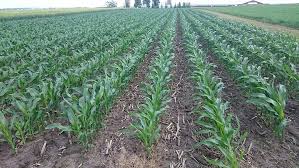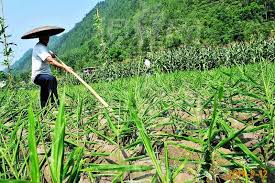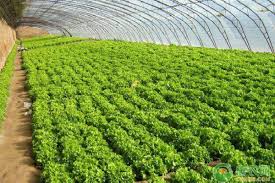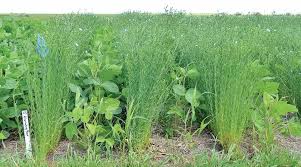Impact of continuous cropping is a significant factor influencing pest and disease dynamics in agricultural systems. Continuous cropping, which involves planting the same crop or crop type repeatedly on the same land without rotating with different crops, has become increasingly common due to the demand for consistent yields and the economic benefits it offers. However, while this practice may provide short-term benefits, it can have long-term consequences for pest and disease management.
One of the primary impacts of continuous cropping is the alteration of pest and disease populations. Many pests and pathogens thrive in environments where their host crops are continuously available. For instance, when a single crop species is grown year after year, it creates a favorable habitat for specific pests and diseases that target that crop.
These organisms can build up in numbers over time, leading to higher infestation levels and disease incidence. The lack of crop diversity means that natural predators and beneficial organisms, which can help keep pest populations in check, may also decline due to the absence of varied food sources.
Moreover, continuous cropping can result in reduced soil health, which indirectly affects pest and disease dynamics. Healthy soils are crucial for maintaining crop vigor and resilience against pest pressures. However, the constant planting of the same crop can lead to nutrient depletion, soil erosion, and a decline in organic matter content.
These factors can weaken plants, making them more susceptible to diseases and pests. Additionally, soil-borne pathogens can accumulate, leading to increased disease risks, particularly when the same crop is grown without adequate management strategies.
Continuous cropping also disrupts the natural cycles of pest and disease populations. In a diversified cropping system, crop rotation can break the life cycles of pests and pathogens. Different crops often have different planting and harvesting times, which can prevent pests from completing their life cycles and reduce their populations. In contrast, the predictability of continuous cropping allows pests and diseases to adapt more readily to their hosts, leading to more severe outbreaks and a need for increased pesticide applications.
Furthermore, the reliance on chemical controls to manage pests and diseases in continuously cropped systems can create a cycle of dependency. Farmers may resort to more frequent pesticide applications, which can lead to pest resistance over time.
As pests adapt to these chemical controls, they may become harder to manage, prompting farmers to use even more potent chemicals or higher doses, further exacerbating resistance issues. This not only increases production costs but can also have negative environmental and health implications.
The economic implications of continuous cropping on pest and disease management cannot be overlooked. While the immediate financial benefits of growing the same crop may seem appealing, the long-term costs associated with increased pest and disease pressure can negate these advantages. Farmers may face higher costs from pesticide applications, reduced yields from pest damage, and potential losses from crop failures due to diseases.
Benefits of Continuous Cropping in Agriculture

1. Increased Crop Yields: Continuous cropping allows for the maximum utilization of land, leading to higher total annual yields compared to fallow periods. This practice can boost overall productivity as multiple crops can be harvested within a single growing season.
2. Enhanced Resource Use Efficiency: With continuous cropping, farmers can optimize the use of water, nutrients, and sunlight, as plants are actively growing throughout the year. This efficient use of resources contributes to sustainable farming practices.
3. Diversification of Income Sources: Growing different crops continuously can provide farmers with varied income streams, reducing reliance on a single crop and protecting against market fluctuations and crop failures.
4. Improved Crop Management: Continuous cropping enables farmers to gain better knowledge of specific crop needs and pests, allowing for more tailored management practices that can enhance productivity and reduce costs.
5. Year-Round Employment Opportunities: Continuous cropping creates more labor opportunities throughout the year, benefiting local communities by providing consistent work and income.
Pest and Disease Dynamics in Continuous Cropping Systems
1. Increased Pest Pressure: Continuous cropping can lead to the buildup of specific pests and diseases that thrive on certain crops, increasing the likelihood of infestations and outbreaks due to the lack of crop rotation.
2. Resistance Development: Pests and pathogens may develop resistance to pesticides when continuously exposed to the same crops, complicating management efforts and necessitating the use of more aggressive control measures.
3. Enhanced Monitoring Needs: Farmers must implement more rigorous monitoring and scouting strategies to detect pest and disease outbreaks early, as the uniformity of crops can make it easier for problems to spread quickly.
4. Integrated Pest Management Strategies: Continuous cropping systems may require more robust Integrated Pest Management (IPM) strategies to manage pest populations, including biological control methods, cultural practices, and resistant crop varieties.
5. Effects on Beneficial Organisms: The continuous presence of specific crops can disrupt the balance of beneficial organisms in the ecosystem, potentially leading to a decline in natural pest control agents.
Read Also: 13 Medicinal Health Benefits of Chenopodium vulvaria (Stinking Goosefoot)
Effects of Continuous Cropping on Soil Health

1. Nutrient Depletion: Continuous cropping can lead to the depletion of essential soil nutrients, as crops continuously extract nutrients without allowing the soil to recover during fallow periods, resulting in reduced soil fertility over time.
2. Soil Structure Deterioration: The repeated tilling and compaction of soil from continuous cropping can negatively impact soil structure, leading to reduced porosity, drainage, and aeration, which are critical for healthy plant growth.
3. Increased Soil Erosion: Continuous cropping, especially on sloped lands, can lead to soil erosion as there is less organic matter and root structure to hold the soil in place, exposing it to water and wind erosion.
4. Changes in Soil Microbial Communities: Continuous cropping can alter soil microbial communities, potentially leading to a decline in beneficial microbes that contribute to soil health and nutrient cycling.
5. Need for Soil Amendments: To mitigate the negative effects on soil health, continuous cropping may require the addition of organic matter, cover crops, or other soil amendments to maintain fertility and structure.
Influence of Continuous Cropping on Pest Populations
1. Pest Population Increase: Continuous cropping can lead to a rise in specific pest populations as they adapt to the consistent availability of their preferred host crops, creating a more conducive environment for pest survival and reproduction.
2. Limited Natural Predators: The uniformity of crops in continuous cropping systems may limit habitats for natural predators and beneficial insects, which can help control pest populations, thereby allowing pests to thrive unchecked.
3. Development of Pest Resistance: Continuous exposure to the same crops can contribute to the development of resistance in pest populations, making it increasingly challenging to manage infestations with conventional control measures.
4. Seasonal Variability in Pest Dynamics: Pests that thrive on specific crops may exhibit seasonal population peaks, leading to increased pest pressure during particular times of the year when crops are at their most vulnerable stages.
5. Need for Enhanced Monitoring: Continuous cropping necessitates more frequent monitoring and scouting for pests, as the risk of outbreaks can escalate quickly due to the lack of crop diversity.
Disease Resistance and Continuous Cropping
1. Disease Susceptibility: Continuous cropping can make crops more susceptible to diseases, particularly if the same species is grown repeatedly in the same location, as pathogens can accumulate in the soil and infect the crops.
2. Monoculture Practices: The practice of monoculture in continuous cropping can exacerbate disease issues, as pathogens may specialize in specific crops, leading to greater vulnerability and higher disease incidence.
3. Resistance Breeding Challenges: While some crops may be bred for disease resistance, continuous cropping can undermine these efforts, as the pathogens evolve in response to the constant presence of their host crops.
4. Impact on Crop Health: The continuous cycle of planting the same crops can negatively impact overall crop health, leading to reduced vigor and increased susceptibility to diseases.
5. Importance of Crop Diversity: Implementing crop diversity within continuous cropping systems can enhance overall resilience to diseases, as varied crops can disrupt the life cycles of pathogens and reduce their impact.
Integrated Pest Management Strategies for Continuous Cropping
1. Crop Diversity and Rotation: Introducing diverse crops in a continuous cropping system can help disrupt pest life cycles and reduce pest populations, contributing to a more sustainable pest management approach.
2. Biological Control Methods: Utilizing beneficial insects and microorganisms can aid in managing pest populations without relying solely on chemical pesticides, enhancing the sustainability of continuous cropping systems.
3. Cultural Practices: Implementing practices such as soil health management, cover cropping, and maintaining proper sanitation can help create an environment less conducive to pest establishment and spread.
4. Monitoring and Scouting: Regular monitoring for pest populations and damage allows for timely intervention, ensuring that pest pressures are managed before they reach economically damaging levels.
5. Targeted Chemical Use: When necessary, applying pesticides in a targeted manner based on pest thresholds can minimize impact on non-target organisms and reduce the risk of developing pest resistance.
Crop Rotation vs. Continuous Cropping: A Comparative Analysis
1. Biodiversity and Ecosystem Health: Crop rotation enhances biodiversity by introducing various plant species, which can lead to improved ecosystem health, while continuous cropping often reduces biodiversity due to the reliance on a single crop type.
2. Soil Health Impacts: Crop rotation contributes to better soil health by preventing nutrient depletion and improving soil structure, whereas continuous cropping can lead to soil degradation and nutrient depletion.
3. Pest and Disease Management: Crop rotation disrupts the life cycles of pests and diseases, reducing their populations and impact, while continuous cropping can exacerbate pest and disease issues due to the consistent presence of host crops.
4. Yield Stability: While continuous cropping can offer higher immediate yields, crop rotation can lead to more stable long-term yields by improving soil fertility and pest management.
5. Economic Considerations: Continuous cropping may initially appear more economically viable due to reduced planting complexity, but crop rotation can provide more sustainable and resilient economic benefits over time by maintaining soil health and reducing pest management costs.
Read More: 15 Medicinal Health Benefits of Castanea sativa (Sweet Chestnut Tree)
Impact of Continuous Cropping on Beneficial Organisms

1. Reduction in Beneficial Insect Populations: Continuous cropping can lead to a decrease in populations of beneficial insects, such as pollinators and natural predators of pests, due to the lack of habitat diversity and food sources.
2. Soil Microbial Diversity Decline: Repeated planting of the same crop can reduce the diversity of soil microbes, which play a crucial role in nutrient cycling and soil health, leading to diminished ecosystem functionality.
3. Disruption of Food Webs: The simplification of cropping systems can disrupt local food webs, making it difficult for beneficial organisms to thrive, which can impact overall agricultural productivity.
4. Increased Vulnerability to Pests: With fewer beneficial organisms present, crops become more susceptible to pest infestations, as there are fewer natural checks on pest populations.
5. Need for Habitat Management: To mitigate the negative impacts of continuous cropping on beneficial organisms, farmers may need to implement habitat management practices, such as maintaining buffer strips or diverse planting schemes.
Do you have any questions, suggestions, or contributions? If so, please feel free to use the comment box below to share your thoughts. We also encourage you to kindly share this information with others who might benefit from it. Since we can’t reach everyone at once, we truly appreciate your help in spreading the word. Thank you so much for your support and for sharing!
Read Also: Characteristics and Strategies of Industrial Products

